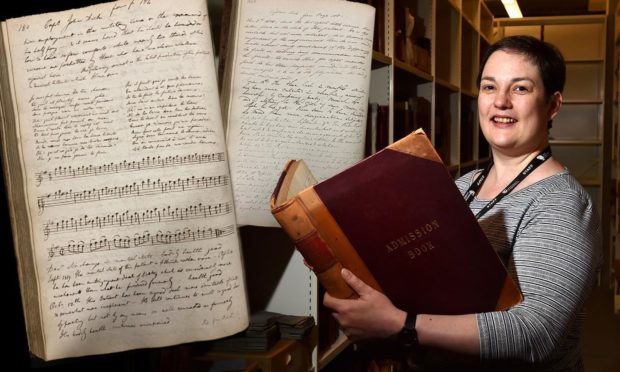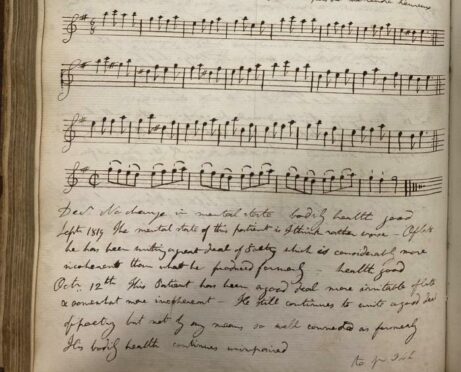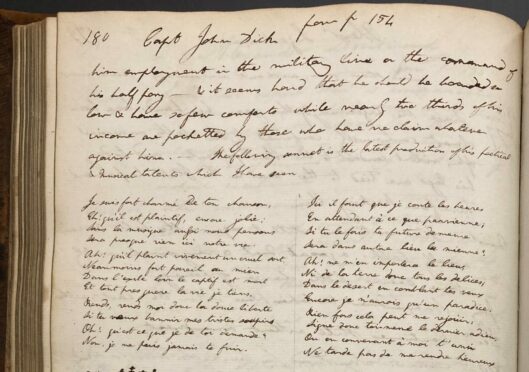As the archivist for NHS Grampian, Fiona Musk has come across some tantalisingly small glimpses of intriguing hospital patients from centuries past.
There was Elizabeth Collie, the factory operative from Woodhill who was admitted to Aberdeen Lunatic Asylum for a couple of months in 1849 due to her “abuse of tea”.
A few cells down from her in the asylum’s records is a carpenter from Inverurie named Alexander Sinclair, who was brought in for treatment due to “vegetable poisoning”.
These entries are all the more fascinating for their lack of detail – we know nothing about the drugs that were used to treat these people, or how they spent their free time, or what happened to them before or after their admittance.
“There’s definitely people where the only record of them is in these medical records,” Ms Musk said.
“There might be a register of their baptism and of their death and that’s it, but then you come across them at their most vulnerable, being admitted to an asylum.”
A noteworthy find
When three missing volumes of 200-year-old case notes were returned to the archives earlier this year, Ms Musk discovered something that made her want information more desperately than ever before.
Among the dry descriptions of behaviour and medical reactions, there was a small melody: musical notes written out on a stave.
Below, the doctor had written: “For some time past the captain has been quieter, not so irritable. He is busy at present in writing out variations to a tune which he said he composed in his sleep.”
Ms Musk said: “The fact there is music in the case notes is extremely unusual, and why would a doctor decide to write them down?
“I had a look to see if I could find out more about the person who the case notes referred to.”
The archivist was in luck. There was no shortage of information waiting to be found on this particular patient.
Figure in history
Captain John Dick was born around 1770, presumably in Scotland. His precise birthplace remains unknown, though some details point to him living in the Perth area.
One of those details is his service in the 42nd Regiment of Foot in the British Army – now the Black Watch – which was headquartered in the town.
Capt Dick fought with the regiment in Egypt during the bloody Battle of Alexandria in 1801, receiving a serious wound that led to “profuse bleeding” and ultimately “symptoms of mental weakness”.
It is possible that this is the event that led to his admittance, 14 years later, to the Aberdeen Lunatic Asylum, now the Royal Cornhill Hospital.
It was just the latest in a list of retreats where he had been sent by family and friends, including some in the vicinity of Glasgow and Edinburgh, but Capt Dick would stay in Aberdeen for close to nine years.
For that entire period, doctors took extensive notes to create a fascinating image of the man, his eccentricities and his interests.
Man of many talents
“Part of the reason his case notes are so detailed is, he sounds like he was quite a character,” Ms Musk said.
In one entry, he has taken up painting and is occupied in creating a self-portrait. In another, he has somehow managed to get a canary into the building for some company.
Ms Musk added: “At another point, his notes say he’s very anxious that some ladies would come and see him, and that the only thing he wants is a wife.
“A few years after that, there is another mention: ‘The captain is once more in love, and is beginning to give me letters to the young lady he admires.'”
Capt Dick also passed his time “very pleasantly, amusing himself by playing the flute” – occasionally performing duets with Mr Sutherland, a violinist who may have worked at the asylum as a doctor or attendant.
And in a discovery rivalling the short piece of music, the case notes from 1818 also including a pair of sonnets written by the veteran – in French.
The two poems are fairly opaque and do not shed much on Captain Dick’s state of mind, although the first contains the evocative line “Rends, rends moi donc la donce liberte“: “Give back, give me back the gift of freedom”.
The gift of freedom
It was another six years before Capt Dick left the asylum for the final time, in October 1824. He would have been around 55.
The entry describing his discharge is short, but hints at optimism for his unrecorded future.
It reads: “Dick’s comforts, having been increased by his being provided by a better bedroom, well-furnished by the orders of the managers, he became more settled, which induced his friends to remove him this day on trial. Discharged, improved.”
No more is known about Capt Dick’s life from that point on, but Ms Musk believes his eclectic pursuits in the asylum hint at many more interesting lives – and perhaps more treasures to discover.
She said: “You get all these little insights into what he was doing in the asylum and you think, well, other people must have had these same pastimes.
“Other people must have been painting, writing poetry and playing musical instruments.”



